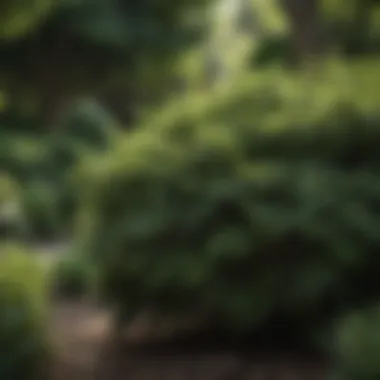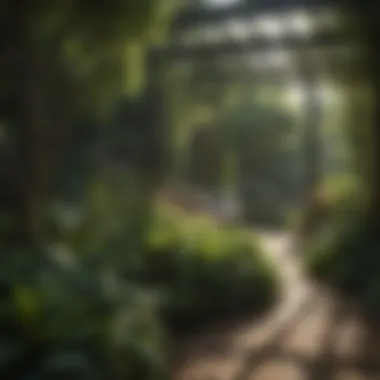Deep Shade Shrubs for Zone 5: A Comprehensive Guide


Intro
Gardening can often feel daunting, especially when it comes to selecting the right plants for specific conditions. Zone 5, known for its variable climate, presents unique challenges for gardeners looking to cultivate lush environments. Among the most significant challenges is the presence of deep shade, which can limit plant options substantially. However, with informed choices, homeowners can transform even the shadiest corners of their property into vibrant and thriving green spaces.
This guide will explore deep shade shrubs specifically suited for Zone 5 conditions. Each section will examine the characteristics of these plants, the intricacies of growing them in low-light situations, and the benefits they can confer on garden aesthetics and biodiversity. By the end of this guide, readers will possess practical knowledge, enabling them to select and care for deep shade shrubs effectively.
Key Insights and Trends
Understanding the landscape of gardening in Zone 5 requires awareness of specific trends and insights relevant to deep shade conditions. The current trends emphasize sustainability and biodiversity. Homeowners are increasingly inclined to create gardens that support local ecosystems while providing beauty and tranquility.
Current Trends in Gardening
- Planting native species is gaining popularity as it supports local wildlife and requires less maintenance.
- Incorporating perennial shrubs, which provide year-round interest, helps in fostering resilience against climate fluctuations.
- There is a growing focus on using layered planting techniques to maximize space and light effectively, even in deep shade.
Popular Gardening Techniques of the Season
- Shade Layering: This involves planting taller shrubs at the back and shorter plants in front to create visual depth while maximizing light capture in layered areas.
- Container Gardening: Utilizing pots and containers allows for better soil management and drainage, especially in shaded patios or walkways.
- Maintenance-Free Gardens: The trend toward xeriscaping and low-maintenance gardens continues, leading gardeners to select hardy, shade-tolerant shrubs that require less attention.
"Gardening in deep shade is often seen as a limitation, but the right shrub selection can transform it into an opportunity for beauty and ecological balance."
Adapting to these trends fosters not only aesthetic appeal but also enhances ecological value in residential spaces.
Practical Tips and How-To Guides
When embarking on the journey of planting deep shade shrubs, several practical tips can facilitate the process. Selecting the right shrubs and understanding their care requirements can make a significant difference in garden success.
Step-by-Step Guides for Planting Deep Shade Shrubs
- Select Shrubs Wisely: Consider species that thrive in low light, such as Hydrangea arborescens, Pieris japonica, or Aucuba japonica.
- Assess the Soil Quality: Check for good drainage and amend soil with organic material to enrich nutrient content and moisture retention.
- Planting Method: Dig a hole twice as wide as the root ball and ensure the top of the root ball is level with the soil surface. Water thoroughly after planting.
- Mulch Application: Apply a layer of mulch around the base to retain moisture and suppress weeds.
- Regular Monitoring: Observe plant health and address any pests or diseases promptly to maintain vigor.
These steps can simplify the planting process and establish a healthy foundation for your shrubbery.
Importance of Care and Maintenance
- Watering: Even though shade-loving shrubs require less water compared to sun-loving variants, consistent moisture is vital, especially during dry spells.
- Pruning: Regular pruning promotes healthy growth and helps maintain desired shape. However, timing should align with the shrub's flowering cycle to avoid cutting off potential blooms.
- Fertilization: Applying a balanced fertilizer in spring encourages robust growth, particularly in nutrient-rich soil.
Caring for deep shade shrubs does not have to be burdensome. With a little knowledge and commitment, anyone can create a peaceful and elegant garden even in the deepest shade.
Prologue to Zone Gardening
Gardening in Zone 5 presents unique possibilities and challenges. Understanding this specific climate zone is crucial for selecting appropriate plants, especially when considering deep shade shrubs. Zone 5 typically experiences minimum winter temperatures ranging from -20°F to -10°F. Therefore, a careful selection of plants can lead to successful gardening. This guide aims to support gardeners in maximizing their lush outdoor spaces.
Understanding Climate and USDA Zones
The USDA Plant Hardiness Zone Map divides the United States into 13 zones based on average annual minimum temperatures. Zone 5, which covers various regions across the Midwest and Northeast, is defined by specific climatic conditions including a growing season lasting around 180 days. The average summer temperatures can vary widely, but they generally provide suitable conditions for a range of plant species.
Properties of this zone include:
- Temperature range: -20°F to -10°F in winter
- Growing season: about 180 days
- Precipitation: Moderate, often benefiting particular shrub types
For gardeners, knowing which plants can thrive in these specific conditions is crucial to achieving a productive garden.
Defining Deep Shade in Gardening
Deep shade occurs where sunlight is severely limited. This can happen in densely wooded areas or on the north sides of buildings. Understanding this concept is essential because not all plants can flourish in low-light conditions.
A location is considered in deep shade if it receives less than two hours of direct sunlight daily. Here are a few factors
contributing to deep shade:
- Tree density: Thick canopies reduce light exposure.
- Tall structures: Buildings or fences can cast long shadows, limiting light.
- Competing foliage: Understory plants and shrubs may further impede light.


Plants adapted to deep shade often have various adaptive traits. By recognizing what constitutes deep shade, gardeners can select shrubs that not only survive but thrive under those conditions, enriching the garden's overall aesthetic and ecological value.
Characteristics of Shrubs in Deep Shade
Understanding the characteristics of shrubs that thrive in deep shade is essential for gardeners in Zone 5. Light conditions in shaded areas can be quite limiting. Shrubs need to develop specific traits to adapt to low light. This adaptation is key to their survival and overall performance.
Choosing the right shrubs for deep shade not only contributes to the aesthetic value of the garden but also enhances its ecological balance. The right selection can support local wildlife and maintain soil health. Here the focus shifts to the distinct adaptations and soil requirements that are critical in deep shade gardening.
Adaptations to Low Light
Plant species that thrive in deep shade have developed unique features to cope with low light. They often have larger leaves. This larger leaf surface maximizes photosynthesis. This means they can capture as much light as possible, even in dim conditions. Many shrubs optimize their growth patterns too. Some shrubs might grow tall and thin, stretching upwards towards available light. Others may have more compact forms to tolerate shade better.
Furthermore, some of these shrubs may also display slower growth rates. This is an important aspect for gardeners to know. Slower growth means they require less frequent trimming and can be low maintenance over longer periods. This stability allows them to settle in their environment without the need for constant intervention.
Plants that thrive in shade also often have modified chlorophyll. This adaptation allows for better absorption of light. This is crucial during the growing season when light conditions vary. This phenomenon can make some shrubs particularly vibrant, enhancing the overall aesthetic of a shaded area. In a way, these adaptations are not just survival traits; they are also opportunities for gardeners to explore unique beauty in their shade gardens.
Soil Requirements and pH Levels
Soil plays a vital role in supporting shrubs in deep shade. The right soil conditions can either promote or hinder growth. Many shrubs prefer well-draining soils rich in organic matter. Organic materials such as decomposed leaves or compost can help enhance soil structure. This increases moisture retention as well, which is beneficial in shaded garden areas where water might not evaporate as quickly.
In terms of pH, most deep shade shrubs thrive in slightly acidic to neutral soils. Understanding the specific pH needs is crucial for selecting appropriate shrub varieties. Testing the soil pH can help determine if amendments are needed. For instance, if the pH is too high, adding sulfur can help adjust it downwards. On the contrary, using lime can raise the pH if necessary.
This insight is not just theoretical. Practical gardening experience shows that shrubs such as Japanese Holly and American Hornbeam flourish in such conditions when given soil rich with organic content and with appropriate pH levels. Therefore, understanding these soil characteristics is fundamental for anyone looking to cultivate healthy shrubs in deep shade.
Key Takeaway: The success of deep shade gardening relies heavily on selecting adaptable shrubs and understanding soil conditions. Knowing these will significantly enhance the sustainability and aesthetic appeal of your garden.
Selecting Shrubs for Deep Shade
Selecting shrubs for deep shade is a critical aspect when creating a flourishing garden in Zone 5. This is because not all shrubs thrive in a low-light environment. Therefore, gardeners in this region need to make informed choices about the plants they bring into their shaded areas. By focusing on specific elements such as size, foliage type, and flowering characteristics, homeowners can ensure their selections contribute positively to both aesthetics and ecological balance.
Key Factors to Consider
Size and Growth Habit
When considering size and growth habit, the chosen shrubs must fit well into the designated area. Large shrubs can overpower small spaces or suffocate surrounding plants. Conversely, smaller shrubs can be lost in vast areas of deep shade. Popular choices for deep shade often have a compact, bushy growth habit. This allows them to occupy space without overshadowing other plants.
One key characteristic to keep in mind is the growth rate of the shrub. Fast-growing varieties can quickly establish themselves but may require regular pruning. This can be both a benefit and a disadvantage. Gardeners might appreciate the rapid growth but find maintenance more demanding.
Foliage Type
Foliage type also plays a significant role in your selection process. Some shrubs have broad leaves that can capture more light, while others may have needle-like leaves, which can be more resistant to shade. Broadleaf evergreens, for example, offer a lush appearance year-round.
Given the choice of leaves, a more diverse range of textures and colors can be achieved in a shaded area, enhancing visual interest. However, you must be aware of the potential for leaf drop in some deciduous varieties during fall; this can affect the overall aesthetic during the colder months.
Flowering Characteristics
Flowering characteristics not only contribute to the aesthetic value but can also attract pollinators to the garden. Some shrubs have vibrant blooms that can brighten up deep shade areas during their flowering season. For instance, shrubs that bloom earlier in the spring can provide visual appeal before the trees leaf out.
It is important to select flowering plants based on your desired seasonal interest. Some shrubs may offer showy blooms, but their flowering period might be relatively short. Understanding these nuances helps in planning a garden that offers beauty throughout the seasons.
Top Shrubs for Zone Deep Shade
American Hornbeam
The American Hornbeam is highly suited for Zone 5 deep shade gardening. Its dense, shade-tolerant nature allows it to thrive where other plants may struggle. A key characteristic of this shrub is its ability to tolerate a range of soil types, including clay and sandy soils. This makes it a versatile choice for various garden conditions.


One unique feature is its attractive bark, which adds visual interest even in winter when many plants go dormant. However, it can be slow to establish, which may be seen as a disadvantage for gardeners seeking quick results.
Japanese Holly
Japanese Holly is a popular option due to its compact growth habit and evergreen foliage. It maintains its glossy, dark green leaves throughout the year, which provides a continuous source of color. This shrub’s adaptability to shade makes it a particularly appealing choice for deep shade gardens.
Furthermore, it can withstand light pruning, allowing gardeners to maintain its desired shape. A minor disadvantage is its susceptibility to certain pests if not properly cared for, which requires regular monitoring.
Variegated Willow
Variegated Willow is another excellent choice, known for its fascinating multi-colored leaves. This shrub adds a lively touch to shaded areas with its yellow, green, and white foliage. One of its key characteristics is its rapid growth, making it effective for filling empty spaces quickly. This shrub also has a strong tolerance of wet soils, which is beneficial in areas prone to excess moisture.
However, its aggressive growth can become a challenge, as it may require frequent trimming to maintain control over its size and spread. Gardeners must weigh the benefits of its fast growth against the need for regular maintenance.
Selecting the right deep shade shrubs is essential for creating an aesthetically pleasing and sustainable garden environment. Each shrub offers unique benefits and considerations that can be tailored to individual preferences.
Gardeners must understand the specific needs and characteristics of each shrub to make effective choices that contribute to a thriving garden. Whether it's for visual appeal or ecological balance, the right selection can transform shaded areas into productive green sanctuaries.
Planting Techniques for Shrubs in Shade
Understanding the appropriate planting techniques for shrubs in shade is crucial for achieving a thriving garden in Zone 5. This section delves into specific strategies that facilitate successful growth in low-light conditions. The right planting approach not only supports healthy root development but also optimizes the use of available resources, such as soil nutrients and moisture. These carefully considered practices help ensure that shade-loving shrubs can establish a robust presence despite environmental challenges.
Ideal Planting Conditions
Creating ideal planting conditions is essential for the survival of any shrub, particularly in deep shade. Such environments often have different light and moisture levels than sunnier spots. To promote healthy growth, consider the following elements:
- Soil Quality: Begin with well-draining soil rich in organic matter. Incorporating compost can enhance nutrient content and improve drainage.
- Moisture Levels: Monitor the moisture levels carefully. While some shrubs thrive in moist conditions, others need drier environments. Regularly check the soil to ensure it suits your selected species.
- Temperature Considerations: In shaded areas, temperature may vary more than in sunnier locations. Protect young plants from extreme fluctuations by selecting planting times in spring or early autumn.
Key Note: Ensure to plant at the right depth. Roots need enough space to expand without any obstruction.
Spacing and Arrangement Guidelines
Proper spacing and arrangement of shrubs in a deep shade garden is vital for their overall health and visual appeal. Implementing distance guidelines prevents overcrowding that can lead to increased competition for light and nutrients. Consider these points for effective arrangement:
- Species Needs: Research the growth habits of your chosen shrubs. Some species may require more space to flourish, while others can thrive in denser planting.
- Planting Configuration: Plan your planting layout based on the anticipated mature size of shrbs. For instance, larger species like the American Hornbeam or Variegated Willow should be planted further apart to prevent shading smaller plants.
- Layering Technique: Utilize layering by placing taller shrubs in the back and shorter ones in front. This arrangement not only creates depth but also ensures more foliage gets sunlight, even in deep shade.
Effective spacing does not only aid in health but also promotes aesthetic cohesion.
Caring for Deep Shade Shrubs
Caring for deep shade shrubs is crucial for their health and vitality. These shrubs often grow in environments with limited sunlight, which affects their growth and resilience. Hence, regular care can significantly enhance their structural integrity and aesthetic appeal. Appropriately managing water, nutrients, and maintenance tasks contributes to the long-term success of these plants. The following sections detail essential practices that ensure your deep shade shrubs thrive.
Watering Requirements
Watering is fundamental for any plant, but it is especially important for deep shade shrubs. Since these plants may have limited access to natural precipitation, ensuring adequate moisture is vital. The watering needs can vary depending on the type of shrub and the specific soil conditions in your garden.
- Frequency: Typically, deep shade shrubs require watering once a week. However, during dry spells or hotter months, more frequent watering may be necessary.
- Method: When watering, aim for deep irrigation, allowing the moisture to penetrate the root zone. This encourages deeper root growth, which improves drought resistance.
- Observation: Check soil moisture regularly. If the top inch of soil feels dry, it is time to water again.
Lack of proper watering can lead to wilting or even death of the plant. Overwatering, on the other hand, can cause root rot. Finding a balance is key for successful shrub care.
Fertilization Practices
Fertilization helps deep shade shrubs by providing necessary nutrients that may be lacking in the soil. Given the often ideal but less nutrient-rich conditions of shaded areas, the right fertilization techniques are essential for promoting healthy growth.
- Timing: Apply fertilizer in early spring, just before new growth begins. This timing helps shrubs absorb nutrients during their active growing period.
- Type: Use a slow-release fertilizer, which ensures a consistent supply of nutrients over time. A balanced fertilizer formula, such as a 10-10-10 or similar, works well.
- Application: Follow the manufacturer’s instructions for application rates. Disperse the fertilizer evenly around the shrub’s base, keeping it away from the stem.


Regular fertilization, at the right times and with the proper products, can make a significant difference in shrub health and flowering capacity.
Pruning and Maintenance
Pruning and maintenance are integral parts of caring for deep shade shrubs. Regular attention to these activities helps maintain the desired shape, promotes airflow, and encourages fresh growth.
- Timing: Prune shrubs during late winter or early spring when plants are still dormant. This minimizes stress and supports vigorous growth.
- Technique: Use clean, sharp pruning tools. Remove dead, damaged, or crossing branches to improve air circulation and reduce disease risk.
- Maintenance: Regularly inspect your shrubs for signs of pests or diseases. Keeping a close eye helps catch issues early.
In summary, proper care for deep shade shrubs involves attentive watering, suitable fertilization, and timely pruning. Recognizing the unique needs of these plants increases their potential for a thriving, flourishing growth, contributing to a lush garden space.
Common Challenges in Deep Shade Gardening
Gardening in deep shade can offer unique beauty, but it also presents specific challenges that every gardener should consider. This section focuses on pest and disease management and the impact of competing vegetation. Understanding these subtleties helps ensure a healthy environment for shrubs, enabling them to thrive even in less-than-ideal lighting.
Pest and Disease Management
Deep shade can create a microclimate that fosters conditions which are more favorable for certain pests and diseases. The tight quarters of dense shade environments can also limit airflow, often resulting in increased humidity. This humidity is a double-edged sword; while it might be beneficial for some plants, it can also create a breeding ground for pathogens.
To effectively manage pests and disease, consider these practices:
- Regular Inspections: Frequently check your shrubs for early signs of distress. Look under leaves and around the base of the plants where insects may hide.
- Use of Neem Oil: This natural pesticide can deter many common pests without introducing synthetic chemicals.
- Fungal Treatments: If fungal issues arise, applying fungicides in the early stages can help mitigate severe damage.
- Maintain Cleanliness: Regularly clear away fallen leaves and debris where pests can harbor and multiply.
Utilizing disease-resistant shrub varieties is another effective strategy. Certain plants are bred or selected to endure harsh conditions that might otherwise lead to issues.
"The best defense against pests is a good offense. Healthy plants are far less likely to be attacked."
Impact of Competing Vegetation
Competing plants can also pose a significant challenge in deep shade gardening. These plants may include grasses or invasive species that can easily outgrow your deep shade shrubs. They monopolize nutrients and water, limiting what is available for your intended plants.
To address this, implement effective management strategies:
- Regular Weeding: Pulling out unwanted plants can keep competition in check.
- Mulching: This not only suppresses weeds but also conserves soil moisture and enhances soil health.
- Selective Pruning: If large trees overshadow your shrubs, periodic pruning can help increase light penetration.
Moreover, understanding the natural ecosystem in your garden plays a critical role. Native plants may harmonize better with your shrubs and potentially reduce competition.
In summary, managing pest issues and addressing the impact of competing vegetation is essential for successful gardening in deep shade. By focusing on prevention and maintenance, gardening enthusiasts can create a thriving shaded sanctuary.
Ending
In the realm of gardening, cultivating deep shade shrubs in Zone 5 offers unique benefits and challenges that every enthusiast must navigate. This article highlights the significance of understanding both the environmental conditions and the specific requirements of different shrub species. Selecting shrubs that thrive in deep shade will result not only in a visually appealing landscape but also in a sustainable ecosystem within a homeowner’s garden.
Deep shade is often disregarded in gardening discussions. However, it serves a purpose. Use of appropriate shrubs can transform dimly lit areas into vibrant niches. These plants require lower light levels, making them ideal for spaces overshadowed by trees or structures. Such understanding aids in making informed plant choices, ensuring a thriving garden despite limited sunlight.
As emphasized, key aspects include moisture retention and soil conditions. Adapting to these elements is fundamental for shrub health. Additionally, recognizing potential challenges, such as pests and competing vegetation, can aid in proactive management, leading to healthier plants.
This guide serves as a comprehensive resource, covering practical aspects from selection to care. Belligerent about deep shade gardening will surely lead to deeper ecological value and sustained interest. Readers are encouraged to approach their gardening endeavors in Zone 5 with a fresh perspective and an informed mindset.
"Choosing the right plants for your garden transforms the limitations of your environment into opportunities for beauty and biodiversity."
Ultimately, embracing the unique characteristics of deep shade shrubs empowers gardeners to create lush sanctuaries, fulfilling their aesthetic desires while protecting local ecosystems.
Key Takeaways
- Deep shade can be seen as an asset in gardening, with appropriate shrubs creating beauty and sustenance.
- Understanding local climate conditions and specific shrub needs is pivotal.
- Water, soil, and pH adaptations enhance shrub vitality and growth in shaded areas.
- Addressing potential challenges like pests ensures long-term shrub health.
Future Considerations for Zone Gardeners
As gardening trends evolve, the significance of native and low-maintenance plants becomes increasingly clear. Zone 5 gardeners should explore options that not only fit the aesthetic of deep shade gardening but also support biodiversity.
- Look for shrubs that provide habitat for local wildlife.
- Consider the long-term sustainability of your plant choices, factoring in growth habits and maintenance needs.
- Stay updated on pest management techniques that align with earth-friendly practices.
- Engage with local gardening communities to share knowledge and best practices.
By adopting a holistic approach, gardeners can ensure not just the health of their individual plants, but also the overall vitality of their garden and surrounding environment.



